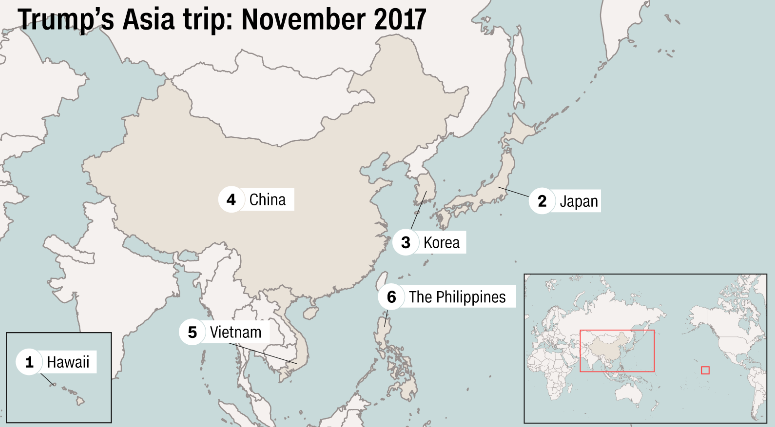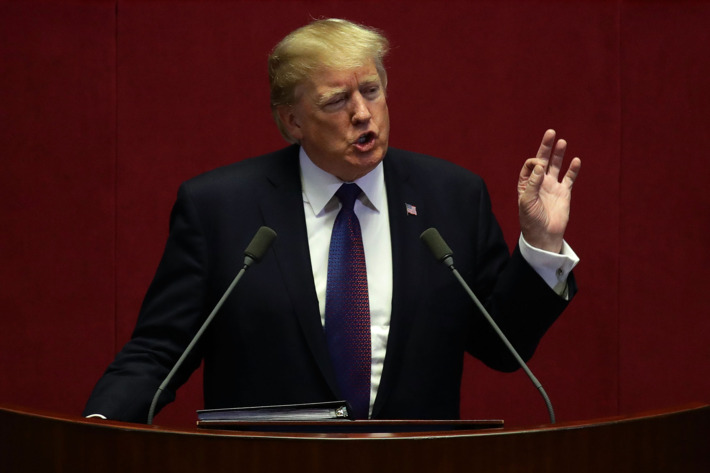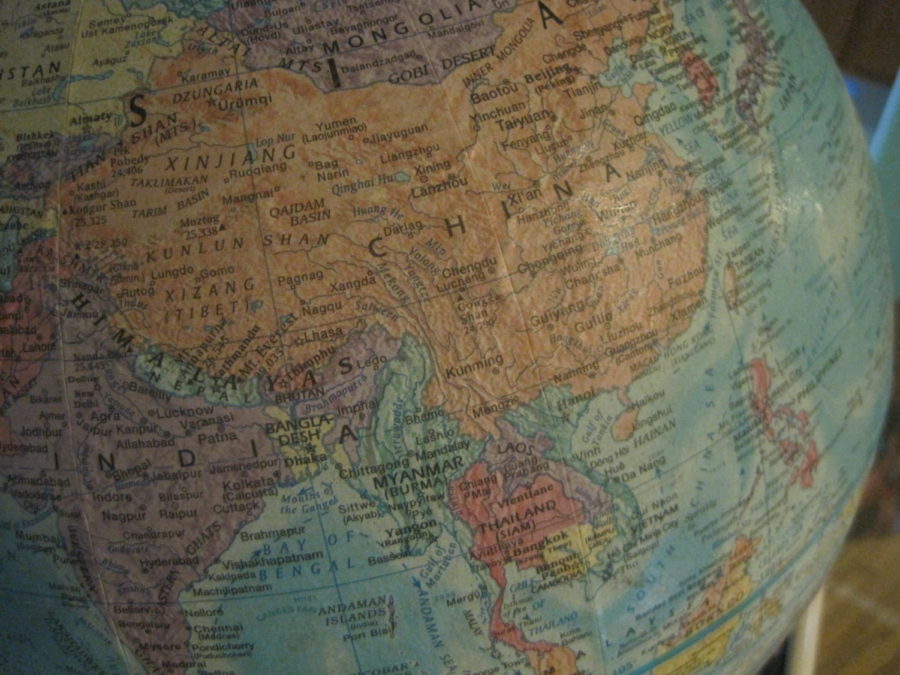Your donation will support the student journalists of ELEANOR ROOSEVELT HIGH SCHOOL - CA. Your contribution will allow us to purchase equipment and cover our annual website hosting costs.
Danny Nguyen of the Roosevelt Review
Southeast Asia is the next world frontier for President Trump as he attempts to renew relationships and discuss with his allies in the region on how to deal with the North Korean nuclear threat.
Trump’s trip in Asia starts in Japan, talks about North Korea and trade
November 11, 2017

(From left to right) First Lady Melania Trump, President Trump, Chinese President Xi Jinping and his wife Peng Liyuan pose for a photo with the Forbidden City in ther background. Trump arrived in China Wednesday afternoon of Nov. 8 just after his recent trip in South Korea.
—–3rd UPDATE—–
President Trump is now traveling to the city of Hanoi, Vietnam for a state meeting before departing for the Philippines, the last Asian country he will visit on his trip.
During his flight to Hanoi, he has made comments regarding Russia’s involvement with the 2016 U.S. election, saying that he considers Russian President Vladimir Putin’s denial of Russian interference “sincere.”
“[ Putin ] said he absolutely did not meddle in our election,” Trump said on Air-Force one as he heads for Hanoi.
—–2nd UPDATE—–
Trump is moving at a quick speed as he has already left China and is now currently in Vietnam on Friday of November 10, set to attend the APAC summit in the city of Da Nang to talk with leaders from other nations about trading deals.
—–1st UPDATE—–
President Trump and First Lady Melania Trump arrived in China Wednesday afternoon of Nov. 8 to met with Chinese President Xi Jinping and his wife, Peng Liyuan. They took Trump and Melania on a tour of the Forbidden City to watch a traditional Chinese opera and had a private dinner where they discussed major issues revolving around Southeast Asia, particularly on the North Korean nuclear threat.
Prior to arriving in China, Trump was in South Korea. On Tuesday of Nov. 7, he had met with President Moon Jae-in to renew the countries’ ties and talk about South Korea’s commitment in defending itself in the Korean Peninsula.
Trump then gave a speech to the South Korean National Assembly early Wednesday of Nov. 8 where he warned North Korea “to not try us” and “do not underestimate us.”
He was suppose to make a visit to the Demilitarized Zone, but canceled the event due to limited time and bad weather.
——————————————————————————————————————————————————————————————–
President Donald Trump began his trip – perhaps the longest foreign trip a U.S. president has made in recent years – to Asia with the intent to strengthen his relationships with countries in Southeast Asia, particularly to counter the threat North Korea poses to the region.

President Trump began his trip to Asia at the U.S state of Hawaii. From there, he arrived in Japan on Sunday November 5 and stayed there until November 6. Trump will head next to South Korea, then to China, Vietnam and will end his trip at the Philippines.
His first stop was Japan from the state of Hawaii on Nov. 5 to 6, where he met with the country’s Prime Minister Shinzo Abe, calling for the nation to take advantage of U.S anti-missile batteries to counter potentially dangerous missiles coming from North Korea.
“[Abe] will shoot them out of the sky when he completes the purchase of a lot of military equipment from the United States,” Trump said Monday during a news conference with Abe.
Trump will then head to South Korea Tuesday morning of Nov. 7 to visit President Moon Jae-in and talk about trade as well as finding methods to pressure next-door neighbor North Korea in stopping its nuclear program.
Afterwards, he will go to China, Vietnam, where attend a summit to express his plans for the continued relationships with his Asian allies, and the Philippines.
In Japan, Trump first appeared at the Yokota Air Base to meet U.S. troops stationed here, praising them of their efforts for “keeping us all safe.”
He had a meeting with Abe, who he regarded as a formidable leader and saluted as among his best friends when it comes to world leaders.

Trump speaks in front of the South Korean National Assembly on early Wednesday of November 8, condemning North Korea.
Trump remarked on the trade imbalances with Japan and expressed his disappointment that Prime Minister Abe did not shoot down missiles fired by North Korea over Japan.
Japan, according to Trump, has been “winning” for decades on their trade relationship and regarded their current relationship as “not fair and not open.” He wishes to reshape the nations’ trade relationship.

On his roughly 10-day tour in Southeast Asia, President Trump made his first stop at Japan. Here, he walked with Japanese Prime Minister Shinzo Abe. The two discussed about North Korea, the most important topic of their talks.
Abe did not comment on the issue of trade between his country and the U.S, but does agree to work with the United States in handling the situation with North Korea.
“The Japanese government already buys a lot of U.S military hardware, but our nation should enhance our defense capability,” Abe said.
Trump also defended his usage of inflammatory statements about North Korea and its leader Kim Jong-Un he has made in the past, noting that “some people said that my rhetoric is very strong, but look what’s happened with very weak rhetoric over the last 25 years. Look where we are right now.”
He has continued to denounce the hermit kingdom, declaring that the U.S “will not stand” for Pyongyang’s threats against his country and that North Korea is “a threat to the civilized world.”
With Abe, the U.S President and his wife Melania Trump also paid a visit to see Japanese families whose young children had been abducted by North Korea in the past. They wanted to highlight the issue, with Trump saying that “no child should ever be subjected to such cruelty.”
There are some reactions from ERHS students on campus regarding Trump’s trip.
Myles Takahashi, a senior at ERHS, said that Trump’s trip to Asia will be “good for trade,” referring to the importance of maintaining good relations with those Asian nations who happen to be trading partners with the U.S.
Kevin Tao, another senior at ERHS, agrees, saying that the trip to Asia will be “fine.” While Tao is only merely aware of Trump’s trip to Asia, he has commented on the North Korean threat in Southeast Asia, noting that “China doesn’t like North Korea anymore,” when asked about the complex relationship between North Korea and China, which is still the hermit kingdom’s major trading partner today.
In lieu of Trump’s harsh comments about unfair trade deals with China, South Korea and Japan, Trump’s trip, in the words of senior Samir Nomani, is “necessary.”
“This trip comes in concern of the need for defense of South Korea from North Korea,” Nomani said. “This is [ Trump’s ] attempt to reassure Asia of the North Korean threat, and some people might consider his trip a success if it doesn’t lead to nuclear war.”
On that note, Isaac Bi, another senior from ERHS, has said that the trip is a “good idea” and does have the potential to be “successful, so long as Trump avoids saying anything ridiculous.”
“It is meant to renew relationships, particularly with South Korea, as the animosity is evident by the fact that South Korea is threatening to pull out of the nuclear defense system set up by the U.S,” Bi said in an interview.
Further adding to his comments, Bi has said that “Trump’s nuclear policy in Asia is no different from those made during the Cold War era.”
